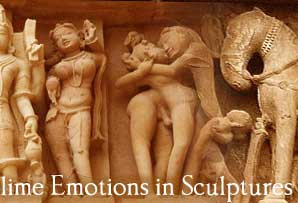 The Khajuraho village surrounded by the mountains of
Chatarpur district of Madhya Pradesh is 395 Km southeast of Agra. Today
this village remains with 22 temples, which give us a glimpse of a
golden time of art and devotion at their peak. Out of 22 temples, two
were made from sandstone. The stone blocks were first carved and then
the interlocking pieces were assembled to form a temple. Each temple is
different from one another.
The Khajuraho village surrounded by the mountains of
Chatarpur district of Madhya Pradesh is 395 Km southeast of Agra. Today
this village remains with 22 temples, which give us a glimpse of a
golden time of art and devotion at their peak. Out of 22 temples, two
were made from sandstone. The stone blocks were first carved and then
the interlocking pieces were assembled to form a temple. Each temple is
different from one another.Western Group
Kandariya Mahadeo
The 31m high temple is the largest and most typical Khajuraho temple with exquisite carvings and intricate and detailed craftsmanship in stone depicting divine deities, celestial maidens, eternal lovers, gods and goddesses. This temple is dedicated to Lord Shiva and enshrines the 'linga'.
Chaunsath Yogini
The temple is the earliest temple of the group that has survived. It belongs to 900 AD and is dedicated Goddess Kali. It has the distinction of being the only granite temple here.
Chitragupta Temple
This temple is dedicated to the Sun God (Surya Dev). It faces towards east or the rising sun and the imposing image of the image of the deity in the inner sanctum is as high as five feet and is shown driving a horse-drawn chariot. It is in front of this temple and the Vishwanatha temple that most of the dance performances take place during the Khajuraho Dance Festival.
Vishwanatha Temple
This temple has impressive entrances with magnificent stone guarding its northern steps and royal masonry elephants taking care of the southern steps. The three-headed image of Lord Brahma in the temple is not less captivating.
Lakshmana Temple
A pretty Vaishnava temple flaunts a lintel over its entrance depicting the divine trinity of Lord Brahma, Lord Vishnu and Lord Shiva along with Goddess Lakshmi, the wife of Lord Vishnu.
Matangeshwara Temple
Situated outside the premises of Western group of temples, this Lord Shiva's temple is known for the daunting eight-feet high lingam (male organ representing the natural process of reproduction and the continuity of human life form) that it enshrines.
Eastern Group
Parsvanatha Temple
The largest Jain temple of the Eastern group, Parsvanath temple has intricate stone carvings, especially, the sculptures on the northern outer wall of the temple are certainly praiseworthy. It enshrines a throne facing the bull emblem that represents the the first tirthankara, Adinatha.
Ghantai Temple
This Jain temple has remarkable frescos depicting the 16 dreams of the mother of Lord Mahavira at the time of his birth and a Jain goddess mounted on a winged Garuda.
Adinatha Temple This temple is richly ornamented with delicate and pretty scultures including those of yakshis. It is dedicated to the first Jain tirthankara (saint), Adinath.
Most of the temple here belong to Jain faith but there are three Hindu temples of the group, namely, the Brahma temple enshrining a four-faced linga; the Vamana temple with divine carvings of sensuous celestial maidens in various poses adorning its outer walls and the Javari temple with a opulently carved doorway and ostentatious sculptures on its exteriors.
Southern Group
Duladeo Temple
This Shaiva temple is known for flaunting the striking images of the celestial maidens or apsaras and richly ornamented figures.
Chaturbhuja Temple It is the huge imposing intricately carved image of Lord Vishnu in the temple's sanctum, which is the chief attraction of the temple.









